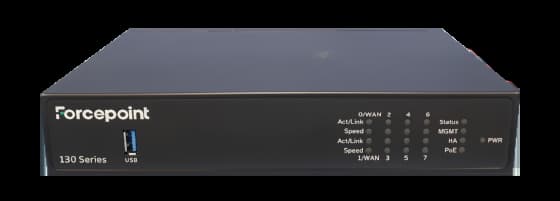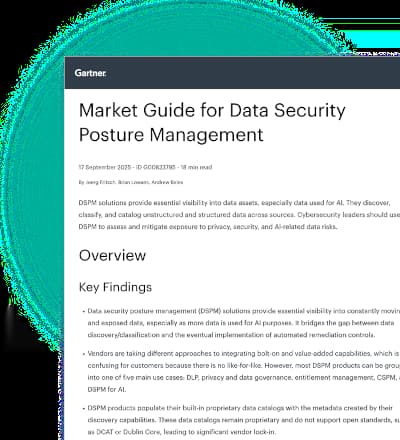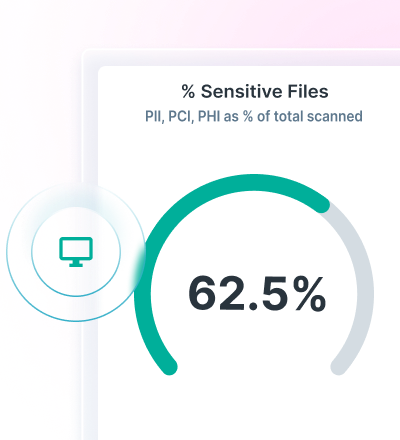
Mais de 12 mil clientes não poderiam estar errados










































Dimensione e proteja o acesso à rede para escritórios, filiais e locais remotos.
Rede de área ampla—encontre a segurança. O Forcepoint Secure SD-WAN protege a rede contra ameaças avançadas com controles de zero trust security enquanto mantém conectividade superior em qualquer lugar do mundo.
Por que Forcepoint Secure SD-WAN?
Centralize o gerenciamento: ative filiais, escritórios e locais remotos a partir da nuvem. Configure políticas apenas uma vez e use a implementação sem toque com o Secure Management Console (SMC).
Melhore o desempenho dos aplicativos: reduza latência e jitter, garantindo que os aplicativos críticos recebam prioridade de largura de banda por meio de conectividade Multi-Link, direção dinâmica de tráfego, monitoramento de integridade de aplicativos e outros recursos.
Proteja contra ameaças avançadas: detecte e evite riscos usando inspeção multicamadas, prevenção de invasões, DNS sinkhole e muito mais, enquanto protege o acesso a aplicativos locais ou remotos por meio do Conector de Aplicativos ZTNA.
Corte custos operacionais: reduza os custos de rede e melhore a confiabilidade com a combinação e ajuste em tempo real de banda larga de ISP local e seleção de MPLS privado.
Datasheet
Compare os modelos de appliance


Global Network
20+
Countries
45+
Cluster Nodes
Clustering In a Way No One Else Can Do
Christian Keller, CISO at Huber + Suhner, lists reliability, clustering, and ability to navigate global compliance requirements among the top benefits of Forcepoint NGFW.
Explore os modelos do Forcepoint Secure SD-WAN

3500 Series
Ideal para grandes empresas, redes de campus e data centers.
Até 66 interfaces
Taxa de transferência do firewall de até 600 Gbps
Taxa de transferência de IPS NGFW de até 140 Gbps

3400 Series
Ideal para redes de campus e data centers.
Até 67 interfaces
Taxa de transferência do firewall de até 200-300 Gbps
Taxa de transferência do IPS NGFW de até 15-35 Gbps

2200 Series
Ideal para escritórios de médio e grande porte.
Até 25 interfaces
Taxa de transferência do firewall de até 120 Gbps
Taxa de transferência do IPS NGFW de até 13,5 Gbps

1200 Series
Ideal para escritórios de médio e grande porte.
Até 17 interfaces
Taxa de transferência do firewall de até 65 Gbps
Taxa de transferência do IPS NGFW de até 5 Gbps

350 Series
Ideal para locais remotos e filiais (design desktop).
Até 13 interfaces
Taxa de transferência do Firewall de 40 Gbps
Taxa de transferência do IPS NGFW de 2 Gbps (N352) ou 4,1 Gbps (N355)

Série 130
Ideal for remote offices, branches and stores.
Até 8 interfaces
Taxa de transferência de firewall 8 Gbps
Taxa de transferência de IPS NGFW 1,600 Mbps

120 Series
Ideal para locais físicos e filiais.
Até 8 interfaces
Taxa de transferência do firewall de 4 Gbps
Taxa de transferência de IPS NGFW de 450 Mbps

60 Series
Ideal para escritórios remotos, filiais e locais físicos.
Até 4 interfaces
Taxa de transferência de firewall 2 Gbps
Taxa de transferência de IPS NGFW 350 Mbps
Imagens de nuvem:
- Software unificado Forcepoint NGFW
- Amazon Web Services (AWS)
- Soluções Microsoft Azure
- Protege a comunicação norte-sul dentro/fora da nuvem e o tráfego SDN leste-oeste
Appliances virtuais:
- Software unificado Forcepoint NGFW
- Disponível para KVM e VMware ESXi e NSX
- Expansível para 64 CPUs
- Automatiza a microssegmentação da rede
- Pode ser agrupado com firewalls físicos


O Guia do Comprador para Secure SD-WAN
Não importa se você está comprando pela primeira vez ou está considerando um upgrade, nosso guia tem os principais critérios para avaliar as soluções de Secure SD-WAN. Descubra as cinco considerações principais que você deve levar em conta.
Por que os clientes escolhem a SD-WAN
Por que os clientes escolhem a SD-WAN
"Our costs - both for the project and maintenance - are going down because we don't need resources locally, we have centralized everything. If we want new service on a train, we define the policy then give the hardware to the operator, who installs it."
VR Group
Frequently Asked Questions
What is managed SD-WAN?
A managed SD-WAN is a service where a provider handles the deployment, configuration, monitoring and optimisation of your WAN. Meanwhile, a cloud-managed SD-WAN adds centralised control via the cloud, making it easier to apply consistent policies, improve performance and maintain security across distributed networks without internal resource strain. Learn more about this product through our comprehensive managed SD-WAN solutions guide.
What are the benefits of SD-WAN?
Benefits of Forcepoint Secure SD-WAN include the following:
Centralized management
Improved application performance
Protection against advanced threats
Reduced operating costs
How much does SD-WAN cost?
SD-WAN costs are determined by factors, including the type of deployment, the size of the network, the number of locations to connect, the type and amount of data transiting the network and any existing infrastructure that may be leveraged when deploying an SD-WAN solution.
What is SD-WAN security?
SD-WAN security helps organizations enable effortless connection to cloud resources while protecting users, data and IT environments from attack.
What is an SD-WAN solution?
Ad SD-WAN solution applies software-defined networking principles to the wide area network.
What is an SD-WAN provider?
SD-WAN providers enable organizations to deploy SD-WAN technology.
What is an SD-WAN appliance?
SD-WAN appliances are physical or virtual controllers located on-premises or in the cloud that connect an organization’s users to applications, services and workloads.
How do SD-WAN appliances work?
SD-WAN appliances and products are designed to overcome the challenges of ensuring fast and secure connectivity for branch locations and hybrid workforces. The traditional wide area network uses a hub-and-spoke model that requires all traffic to flow through a central data center. For organizations with a highly distributed workforce, this model adds unacceptable levels of latency that negatively affect user experiences and productivity. Additionally, legacy WANs are built with costly Multiprotocol Label Switching (MPLS) connections that are time-consuming to manage and deploy, preventing organizations from scaling easily and cost-efficiently. SD-WAN overcomes these issues by creating a virtual overlay for the network that abstracts network connections and enables the use of additional, low-cost transport services that add redundancy and flexibility.
What is Multiprotocol Label Switching (MPLS)?
Multiprotocol Label Switching (MPLS) is data forwarding technology that increases the speed and controls the flow of network traffic.
What is SD-WAN vs MPLS?
SD-WAN is a networking technology that uses software to make wide area networks more intelligent and flexible by connecting sites directly to the internet over commodity broadband links. Configurations and access policies are centrally managed and easily applied across all sites, removing the need to manual administer each WAN device individually. MPLS is data forwarding technology for network traffic that directs data through a path via labels instead of requiring complex lookups in a routing table at every stop. Traditional networking technology, MPLS, has seen competition from SD-WAN solutions to meet today's high demands and expanding needs for networked business-critical systems.










